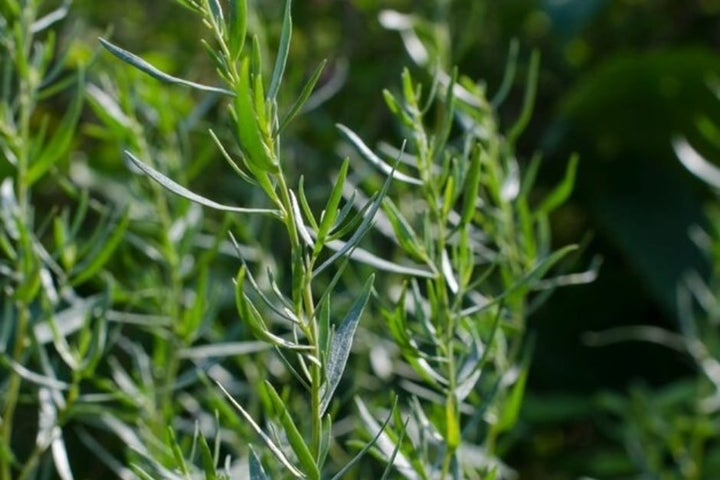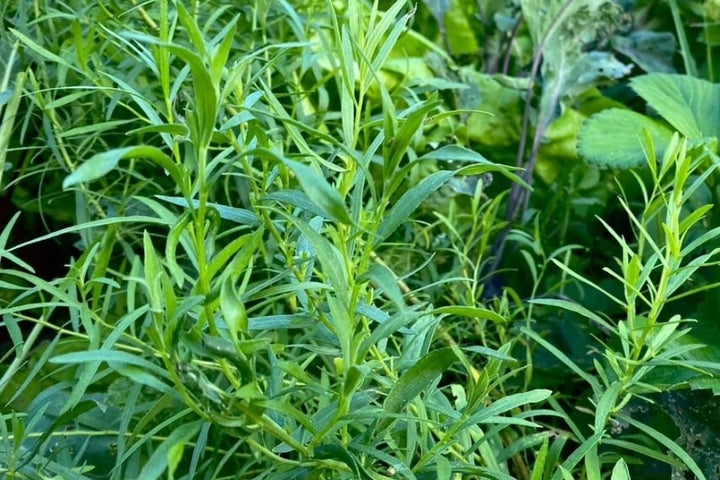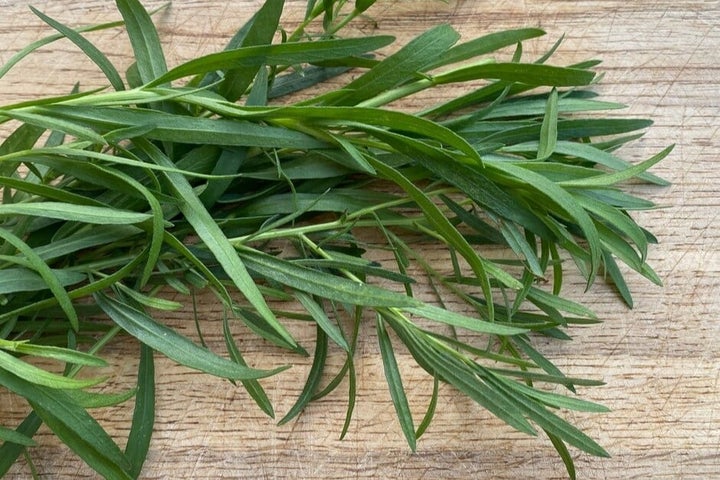Getting Started
Tarragon is a herb with narrow leaves that have a distinctive flavour with a hint of aniseed. There are two main types – French tarragon and Russian tarragon. French tarragon is generally considered the superior type for culinary use. The leaves are often added to chicken, fish and egg dishes. They can also be used with mushrooms, in rice dishes, salads, dressings and sauces, including béarnaise sauce.

Growing you own tarragon and harvesting its young leaves is the best way to enjoy its flavour. Both types of tarragon thrive in a sheltered location in full sun, in well-drained soil or in a container.
Month by Month
Sow
Plant
Harvest
Choosing What To Grow
French and Russian tarragon like similar growing conditions, but differ in size, vigour and leaf flavour. They are both types of Artemisia dracunculus, and plants sold as either can be quite variable, which is reflected by their numerous synonyms. It’s well worth buying tarragon plants in person, so you can check their aroma before purchasing.

French tarragon (Artemisia dracunculus French, syn. A. dracunculus 'Sativa') forms a smaller, more dainty plant, typically 50–75cm (20–30in) tall and about 30cm (12in) wide. Its slender, smooth leaves have a peppery flavour with a hint of liquorice, and it's widely regarded as superior to Russian tarragon. It can struggle in UK winters due to the combination of wet and cold weather, so is best grown in a container and moved to a sheltered location over winter.

Russian tarragon (Artemisia dracunculus Russian, syn. A. dracunculus 'Inodora', A. dracunculoides) is a more vigorous and robust plant, growing to about 1m (3½ft) tall and 50cm (20in) wide. It's a good choice for planting in the ground, as it copes far better with UK winters. It doesn't have the same level of warm, aniseed flavour as French tarragon, and is considered more grassy with a slight bitterness.
For inspiration on growing all kinds of herbs, visit the RHS gardens to see how they’re grown and compare the varieties and aromas.
What and where to buy
Russian tarragon seeds are available in garden centres and from online seed suppliers. French tarragon is shy to flower and set seed, so seeds are generally not available to buy. Young plants of both types are available in spring and summer from many gardening retailers and herb nurseries. One plant is usually enough for most needs, so buying a ready-grown plant is often the easier and quicker option.
Recommended Varieties

Russian tarragon
Hardy perennial with a mild peppery flavour. Likes full sun and good drainage.

French tarragon
Excellent strong flavour with a hint of aniseed. May not survive winter wet and cold.
Sowing
French tarragon is generally not available as seed, but Russian tarragon is easy to grow from seed in spring, either indoors or outside. Sow sparingly, as one plant is usually sufficient for most households.
Sowing indoors – in spring, sow a few seeds of Russian tarragon in a small pot of moist peat-free seed compost. Only lightly cover the seeds with a sprinkling of fine and place the pot somewhere warm and bright. When the have several leaves, move each one into an individual pot about 7.5cm (3in) in size. Keep them somewhere warm and bright, and water regularly. The young plants can be outside from late spring to early summer, once they are well rooted and growing strongly (see Planting below).
Sowing outdoors – you can sow Russian tarragon outdoors, directly into the ground or in a container. For best results, sow from mid-spring onwards, when the soil is starting to warm up. Choose a sunny, sheltered spot with free-draining soil, or a large container filled with peat-free . Sow a few seeds on the surface and lightly cover them. Make sure the soil or compost doesn’t dry out, and seedlings should appear in a few weeks.
Planting

Home-grown and bought tarragon plants are best planted outside from mid-spring to early summer. Indoor-raised plants should be gently acclimatised to outdoor conditions first, by hardening off. Both types of tarragon grow well in free-draining conditions and a warm, sunny, sheltered location.
Russian tarragon can be planted in the ground or in a container. French tarragon is best planted in a container, so it can be moved into a sheltered location, such as a greenhouse or porch, to protect it from wet and cold winter weather. If you have very free-draining soil and a sheltered garden, you could risk planting French tarragon in the ground.
Planting in the ground – choose a sheltered planting site in full sun with well-drained soil. If your soil is heavy or stays quite damp, especially in winter, plant in a container or raised bed instead, where drainage will be better. Space Russian tarragon at least 30cm (12in) from other plants, while less vigorous French tarragon can be spaced 20cm (8in) apart.
Planting in a container – choose a container that’s at least 20cm (8in) wide and deep for one plant. Make sure there are plenty of drainage holes in the base. Fill containers with a peat-free and mix in some horticultural grit (up to 25 per cent by volume) to improve drainage.
Plant Care
Once settled in, tarragon needs little maintenance, especially Russian tarragon. French tarragon usually requires some protection from wet UK winters. To prolong leaf harvests through summer, any stems with flower . Tarragon, especially French tarragon, is generally considered a short-lived , so divide plants every few years or take to ensure you always have young, productive plants.
Watering
Water newly planted tarragon during dry spells in the first year after planting. Tarragon is drought tolerant once established and shouldn’t need additional watering when growing in the ground. In containers, the can dry out quickly, so check regularly over the summer and water if needed. Tarragon dislikes damp growing conditions, so take care not to overwater plants in containers or in the ground, especially in cooler weather.
Winter protection
French tarragon often suffers during UK winters due to the combination of cold and wet. It's best grown in a container, so it can be moved somewhere dry over winter, such as a greenhouse or porch. If you don't have anywhere suitable indoors, move pots to a more sheltered spot outside, such as near a building in a rain shadow. In sheltered locations with free-draining soil, it may survive in the ground. Covering the plant with a cloche will improve its chances.
Russian tarragon is a more robust plantand generally survives outside, unless the ground or becomes . In high-rainfall areas, take the same precautions as suggested above for French tarragon.
Propagating
You can sow seeds of Russian tarragon (see Sowing above), or allow it to self-seed. There are a couple of methods of propagating tarragon vegetatively, meaning the new plants will be the same as the parent plant. This is especially useful with French tarragon that tends not to produce viable seed in the UK.
- Divide established clumps in spring. Do this every few years as tarragon is a short-lived . Division is usually the easiest method of propagating French tarragon
- Softwood cuttings taken in summer from new growth
Cutting back
Tarragon is a herbaceous , so the top growth dies back after the first hard frost in autumn, then the plant resprouts in spring. Remove what remains of the previous year's growth in spring, cutting it back to the lowest new shoots near the base.
Harvesting

Harvest tarragon leaves when new growth starts in spring and continue into autumn. Pick from the shoot tips regularly to encourage fresh young growth. Strip the leaves from the stems, then finely chop them and add to salads, sauces and mushroom, fish, egg and chicken dishes. The leaves are best used fresh, but can be dried and stored in air-tight containers for use in winter. Dried leaves have a milder flavour. Tarragon leaves can also be frozen for later use.
Problem Solving
When tarragon is grown in suitably warm, sunny, well-drained conditions, it is generally healthy and trouble free. Russian tarragon is a vigorous and robust plant, but French tarragon tends to be more delicate (see Winter protection above). Tarragon is rarely troubled by diseases, but can be susceptible to rust and – see Common problems below for more information.
Common Problems

Powdery mildews
Powdery mildews are a group of related fungi which attack a wide range of plants, causing a white, dusty coating on leaves, stems and flowers.

Rust diseases
The rusts are amongst the most common fungal diseases of garden plants. Trees, shrubs, herbaceous and bedding plants, grasses, bulbs, fruit and vegeta...


